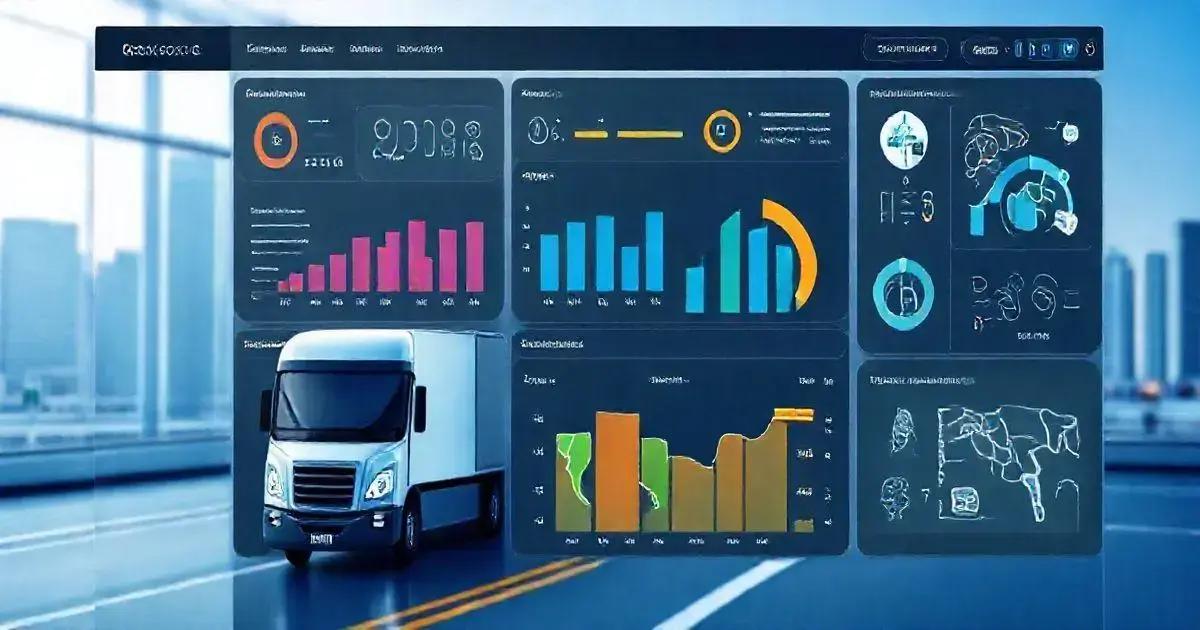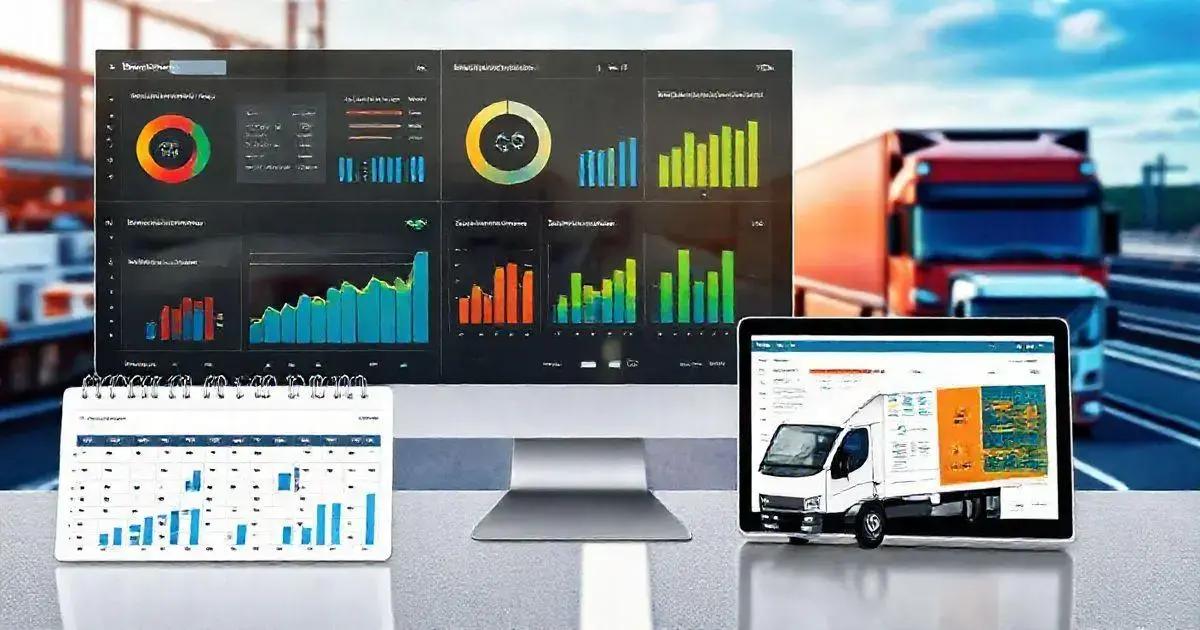5 Essential Features of Fleet Control Worksheet 7.0 Leave a comment
The Fleet Control Worksheet 7.0 is an advanced management tool for fleet managers, offering dashboards for quick insights into vehicle usage, fuel efficiency, and maintenance costs. It includes features for tracking preventive and corrective maintenance, managing travel logistics, monitoring driver performance, and overseeing tire management for safety. Additionally, it organizes essential documents for compliance and operational oversight, ultimately helping businesses enhance efficiency, reduce costs, and improve customer satisfaction.
The Fleet Control Worksheet 7.0 is a powerful tool designed to help logistics and fleet managers keep track of essential data. With features such as initial dashboards, maintenance tracking, and travel control, this worksheet can significantly enhance your operational efficiency. In this article, we will explore its key functionalities.
Overview of Fleet Control Worksheet 7.0
The Fleet Control Worksheet 7.0 is a comprehensive solution for businesses managing a fleet of vehicles. This tool is specifically designed to track and analyze various aspects of fleet operations, ensuring that every vehicle is maintained, utilized, and accounted for efficiently.
One of the standout features of this worksheet is its initial dashboard, which provides a snapshot of critical metrics at a glance. Users can monitor key performance indicators such as the average fuel consumption per vehicle, total kilometers traveled, and the overall maintenance costs. This dashboard not only aids in quick assessments but also helps in making informed decisions.
Additionally, the worksheet facilitates the registration of drivers and vehicles. With dedicated sections for entering detailed information about each driver and vehicle type, fleet managers can maintain accurate records, which are essential for compliance and safety audits.
Another vital aspect is the maintenance tracking capability. The worksheet allows users to schedule preventive maintenance, log corrective actions, and assess the maintenance costs over time. By keeping a close eye on these expenses, companies can significantly reduce downtime and extend the lifespan of their vehicles.
Overall, the Fleet Control Worksheet 7.0 provides a robust framework for fleet management, making it an indispensable tool for logistics and operational efficiency. It not only simplifies data management but also empowers fleet managers to optimize their resources effectively.

Initial Dashboards
The Initial Dashboards of the Fleet Control Worksheet 7.0 are designed to give users a quick and comprehensive overview of fleet performance. These dashboards display a variety of key performance indicators (KPIs) that are crucial for effective fleet management.
Here are some of the key metrics featured on the dashboards:
- KM by Driver: This metric tracks the total kilometers driven by each driver, enabling fleet managers to assess driver performance and efficiency.
- KM per Vehicle: Similar to the driver metric, this displays the distance each vehicle has traveled, providing insight into vehicle utilization.
- KM per Liter: This calculation indicates fuel efficiency, showing how many kilometers are driven per liter of fuel consumed. It’s essential for monitoring fuel expenditures and optimizing routes.
- KM per Trip: By analyzing the distance for each trip, managers can identify patterns in travel and optimize routes to reduce costs.
- Average Consumption per Vehicle: This metric highlights the average fuel consumption for each vehicle, helping to flag any potential maintenance issues or inefficient driving behaviors.
- Total Costs of Mechanical and Electrical Maintenance: By aggregating maintenance costs, the dashboard provides insights into the overall health of the fleet and helps managers budget for future repairs.
- Vehicles in Transit: This metric helps managers keep track of which vehicles are currently on the road, ensuring that resources are allocated efficiently.
These dashboards are not only visually engaging but also interactive, allowing fleet managers to drill down into specific metrics for more detailed analysis. By incorporating these initial dashboards, the Fleet Control Worksheet 7.0 empowers businesses to make data-driven decisions that enhance operational efficiency and reduce costs.
Maintenance Control Features
The Maintenance Control Features of the Fleet Control Worksheet 7.0 play a crucial role in ensuring the longevity and reliability of vehicles within your fleet. These features are strategically designed to streamline the maintenance process, helping fleet managers stay organized and proactive in their approach.
Key aspects of the Maintenance Control Features include:
- Tracking Preventive Maintenance: The worksheet allows users to schedule and record all preventive maintenance tasks. By setting reminders for regular checks and services, fleet managers can avoid costly repairs and ensure that vehicles are always in optimal condition.
- Logging Corrective Maintenance: In addition to preventive measures, the worksheet enables users to log any corrective maintenance actions taken. This feature helps in tracking recurring issues and identifying the need for potential upgrades or replacements.
- Maintenance by Vehicle: With dedicated sections to monitor maintenance activities per vehicle, managers can easily assess the upkeep of each unit. This includes details on servicing dates, the type of maintenance performed, and associated costs.
- Cost Analysis: The worksheet aggregates maintenance costs, providing insights into trends and helping managers budget more effectively. By analyzing these expenses, companies can pinpoint areas where savings can be made.
- Status Updates: Users can categorize maintenance tasks based on their status: scheduled, accomplished, or delayed. This feature enhances accountability and allows teams to prioritize tasks effectively.
- Historical Record Keeping: All maintenance activities are recorded, creating a comprehensive history for each vehicle. This documentation is invaluable for audits and compliance, ensuring that all vehicles meet regulatory standards.
In summary, the Maintenance Control Features within the Fleet Control Worksheet 7.0 not only help in managing routine maintenance but also foster a proactive approach to vehicle management. By keeping a close eye on maintenance activities, fleet managers can enhance the performance and reliability of their fleet, ultimately leading to lower operational costs and increased efficiency.

Travel Control Management
The Travel Control Management features in the Fleet Control Worksheet 7.0 are specifically designed to streamline and enhance the management of your fleet’s travel activities. This component of the worksheet helps ensure that all trips are efficiently tracked and monitored, contributing to better operational oversight.
Key functionalities of the Travel Control Management include:
- Cargo Control Linked to Trips: This feature enables users to manage cargo effectively by linking it directly to specific trips. Fleet managers can track what cargo is being transported, ensuring that the right goods are delivered promptly and efficiently.
- Vehicle Control: The worksheet allows for detailed tracking of which vehicles are assigned to each trip. By maintaining accurate records, managers can optimize vehicle usage and reduce idle time, effectively increasing overall fleet efficiency.
- Driver Control: Keeping track of which driver is operating each vehicle during trips is crucial for accountability. This feature allows managers to monitor driver performance and ensure compliance with driving regulations, ultimately enhancing safety.
- Supply Control: The worksheet facilitates monitoring of supplies needed for each trip, ensuring that all necessary items are in place before departure. This proactive approach helps avoid delays and ensures that drivers have everything they need for successful deliveries.
- Control of All Travel Expenses: Fleet managers can log and analyze all travel-related expenses, including fuel, tolls, and additional costs associated with each trip. By having this information readily available, companies can identify cost-saving opportunities and manage their budgets more effectively.
Overall, the Travel Control Management features in the Fleet Control Worksheet 7.0 provide fleet managers with a comprehensive toolkit to oversee and optimize travel operations. By utilizing these functionalities, businesses can ensure smoother operations, improved accountability, and greater efficiency, leading to enhanced customer satisfaction and reduced operational costs.
Tire Management
The Tire Management features of the Fleet Control Worksheet 7.0 are essential for maintaining the safety and performance of your fleet. Proper tire management not only extends the lifespan of tires but also optimizes fuel efficiency and enhances overall vehicle safety.
Here are the key components of the Tire Management features:
- Identification for Each Tire: The worksheet allows users to assign a unique identification number to each tire in the fleet. This feature facilitates tracking and monitoring for every tire, making it easier to manage replacements and maintenance tasks.
- Tire Change Schedule by KM: Users can set up a tire change schedule based on the number of kilometers driven. This proactive approach ensures that tires are replaced before they reach their wear limits, reducing the risk of blowouts and related accidents.
- Signal of Remaining KM to Change Tire: The worksheet includes a notification system that alerts fleet managers about the remaining kilometers before a tire change is due. This feature helps in planning maintenance schedules effectively, ensuring that tire replacements are timely.
- Status per Action: The Tire Management section allows users to track the status of tires throughout their lifecycle. Actions such as allocation to a vehicle, removal from a vehicle, scrapping, or maintenance can be logged, ensuring comprehensive oversight of tire usage.
By implementing these Tire Management features, the Fleet Control Worksheet 7.0 enables fleet managers to maintain optimal tire conditions, enhancing vehicle safety and performance. Proper tire management contributes to cost savings by preventing premature tire wear and improving fuel efficiency, ultimately benefiting the bottom line.

Document and Registration Management
The Document and Registration Management features of the Fleet Control Worksheet 7.0 are vital for maintaining comprehensive records essential for compliance, safety, and operational efficiency. This aspect of the worksheet ensures that all necessary documentation is organized and easily accessible, helping fleet managers to streamline their processes.
Key functionalities include:
- Driver Document Control: This feature allows fleet managers to track and manage all essential documents related to drivers, such as licenses, certifications, and training records. By keeping these documents organized, companies can ensure compliance with regulatory requirements and enhance safety on the road.
- Vehicle Document Control: Similar to driver documentation, this section enables users to manage all paperwork associated with each vehicle in the fleet. This includes registration documents, insurance policies, and maintenance records, facilitating a clear overview of the vehicle’s status and compliance.
- Comprehensive Registrations: The worksheet includes sections dedicated to the registration of various entities, such as driver registration, vehicle type registration, and service providers. This comprehensive approach helps keep track of critical information that is necessary for operational management.
- Expenditure Type Register: Users can log different types of expenditures related to fleet operations, which assists in budgeting and financial planning. By categorizing expenses, managers can analyze costs effectively and make informed decisions regarding resource allocation.
With these Document and Registration Management features, the Fleet Control Worksheet 7.0 empowers fleet managers to maintain accurate records, enhance accountability, and ensure regulatory compliance. Effective management of documentation not only streamlines operations but also mitigates risks associated with non-compliance, ultimately leading to a more efficient and reliable fleet.
Conclusion
In conclusion, the Fleet Control Worksheet 7.0 is an invaluable tool for fleet managers seeking to optimize their operations.
With its robust features encompassing maintenance control, travel management, tire management, and document organization, it provides a comprehensive solution to enhance fleet efficiency.
By leveraging the initial dashboards, users can gain quick insights into key performance metrics, enabling informed decision-making.
The maintenance control features ensure that vehicles are well-maintained, reducing downtime and operational costs.
Additionally, the travel control management and tire management functionalities streamline logistics while promoting safety and compliance.
Overall, adopting the Fleet Control Worksheet 7.0 can lead to improved operational performance, cost savings, and enhanced customer satisfaction, making it a worthy investment for businesses managing a fleet of vehicles.
FAQ – Frequently Asked Questions about Fleet Control Worksheet 7.0
What is the Fleet Control Worksheet 7.0 used for?
The Fleet Control Worksheet 7.0 is designed to help fleet managers track and manage various aspects of fleet operations, including maintenance, travel, tires, and documentation.
How can I track maintenance activities using the worksheet?
The worksheet allows users to log preventive and corrective maintenance activities, set reminders for service schedules, and analyze maintenance costs over time.
What features are included in the travel control management?
The travel control management features include cargo tracking linked to trips, vehicle and driver management, supply control, and logging of all travel expenses.
How does tire management work in the worksheet?
The tire management features enable users to assign unique identifiers for each tire, schedule tire changes based on mileage, and track the status and maintenance of tires.
Can I manage driver and vehicle documentation with this tool?
Yes, the worksheet includes sections for managing all necessary driver and vehicle documents, ensuring compliance and easy access to vital records.
Is the Fleet Control Worksheet 7.0 suitable for all types of fleets?
Yes, the worksheet is versatile and can be adapted for various types of fleets, whether they are small or large, operational, logistics, or service-oriented.

